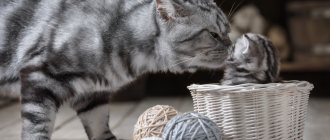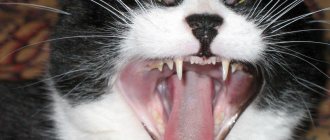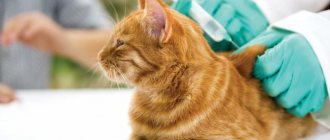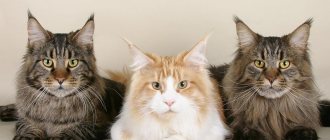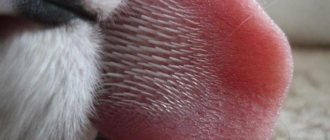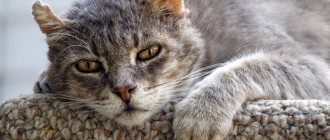How to treat tremors and seizures in cats
When trying to figure out how to cure tremors in a cat, the animal owner often acts by analogy with human diseases. This is the wrong way, because... The organisms of cats and humans are structured differently. Sometimes the owner, without realizing this, begins self-treatment. At the same time, he wastes time: the effect of therapy is not achieved, the signs of the disease are sometimes erased, but the disease itself progresses.
You need to understand that tremor in a cat can be treated only after the cause is determined. Without examination, laboratory and instrumental studies, an accurate diagnosis cannot be made.
Further prognosis depends on the type of pathology. Sometimes a course of vitamins is enough to completely restore the conduction of nerve impulses. However, the disease often cannot be treated. Each specific case requires separate consideration.
The author of the publication is veterinarian Irina Barabash. She began her career as the chief veterinarian of a collective farm, and since 1998 she has been working as a veterinarian and toxicologist chemist at the regional laboratory of veterinary medicine. He combines his main work with writing publications on specialized topics.
Causes
To figure out why a cat bites your legs and rushes at you, you need to carefully monitor it and analyze what is happening.
Both internal problems and external events can cause aggression in an animal. Your pet may bite your legs if:
- he is small and he is teething (in this case, he will bite not only his legs, but also his arms when trying to play with him);
- he lacks vitamins (trying to make up for their deficiency, he will first of all chew on various objects in the apartment; your legs will interest him no less);
- you have spoiled the cat too much and are not raising it;
- in this way the cat demonstrates its love for the owner and encourages him to play with him, attacking on the sly, running away and hiding;
- something hurts (often it is pain that explains why a cat bites its owner’s legs and hisses at the same time);
- the cat is stressed and, rushing at you, tries to draw attention to its dissatisfaction with something: a change in food or place of residence, the appearance of a new family member or another animal in the house, etc.;
- the moment of puberty has approached, unsatisfied desire causes nervousness, and the owner’s legs flashing back and forth in front of the cat irritate and provoke her to aggression;
- often the hunting instinct forces the cat to attack the owner and leave bite marks on his legs.
But be that as it may, it is necessary to understand the facts and eliminate the reasons that provoke the pet to aggression.
Why doesn't the cat drink water?
As a rule, this behavior is associated with the heritage of wild ancestors. Firstly, cats get most of their liquid from food, so if a cat eats wet food, it usually drinks little and rarely.
And secondly, territorial and hunting instincts are involved here. For example, cats love to find water in unexpected places and usually won't drink if the water is near food.
But if dry food is present in the cat’s diet, then he simply needs to drink. For tips on how to increase your cat's interest in water, read this article.
Why does a cat meow for no reason?
In fact, cats almost never meow for no reason, so if you think that a cat meows for no reason, you are most likely mistaken. Take a closer look at what the cat wants to tell you.
Moreover, scientists believe that cats have developed most types of meowing specifically to communicate with humans, because they communicate with each other in other ways.
We have listed the main 10 reasons for cat meowing in this article. If your cat meows often, be sure to read about them.
Why do cats leave home to die?
Some owners think that cats leave the house to die so as not to upset their owners.
In fact, not all cats want to leave before they die, but many look for secluded secret places to hide.
And if the cat can go outside, then such a place may be somewhere in the yard, in the bushes or under the porch. At home, cats most often hide under the bed or in the closet.
The reason for this behavior most likely lies in the fact that a sick, weakened or injured animal instinctively tries to find the safest place to protect itself from attack by predators.
What diseases do cats have?
Hepatopathy in cats: liver diseases, symptoms and treatment
To understand cat diseases, they are divided into groups according to location zones.
Skin and hair diseases
These are visible diseases that the breeder identifies by undoubted signs:
- itching;
- alopecia (hair loss);
- acne, papules (skin rash);
- dandruff;
- wounds with blood and pus.
Such symptoms occur in various skin diseases. Street cats, who can easily catch the infection in yards and garbage dumps, and domestic cats, who do not come into contact with sick animals, are sick.
Skin diseases of domestic cats come in various forms.
- Parasitic, when animals are infected with fleas, ticks, and fungus.
Fleas cause severe itching - flea dermatitis. You can see them if you part the fur. They bite through the skin and release saliva into the blood. The cat scratches this area and inflammation begins.
The infection is brought in by owners from the street on shoes, just like ringworm spores. It spreads quickly. The fur on the head, back and paws falls out. Round bald spots with an uneven scaly surface are formed.
Mites cause scabies. Demodicosis, cheyletiosis (wandering dandruff), and notoedrosis caused by subcutaneous mites develop.
- Allergic reactions that manifest themselves as dermatitis.
Hair falls out on the ears, between the thighs, and on the stomach (atopic dermatitis). Allergies can occur to house dust, detergents, and pollen.
Treat with antihistamines. Find sources of irritation and eliminate them.
When animals are switched to another food, the same reactions may appear, coupled with intestinal disorders.
- Bactericidal infectious diseases.
Bacteria cause either the dry form of the disease in cats (scales and crusts on the skin) or the wet form (ulcers).
Cat ear diseases
In second place among the ailments of pets at home are ear diseases. Inflammation of the outer ear is caused by ear mites.
Feline ear diseases
The ears are a sensitive organ; a sick cat can be seen by the following symptoms:
- scratches his ear until it bleeds;
- prevents you from touching your ears;
- shakes his head;
- there is an unpleasant odor from the ears due to discharge;
- the ears are swollen;
- the cat loses coordination and becomes deaf;
- shortness of breath and nasal discharge appear.
At birth, some kittens have the folded ear mutation. This is a deviation from the norm. Felinologists purposefully consolidated it and created the Scottish Fold breed.
Attention breeders! Scottish Fold cats are crossed only with the British Shorthair or Scottish Straight breed. In all other cases, kittens are born with the bones of the spine fused and immobilized.
Another mutation, the curled ear, is harmless.
Diseases of the stomach and intestines in cats
It is not difficult to determine what your beloved cats are suffering from when they observe diarrhea. These are gastrointestinal diseases. They are:
- Viral.
This is peritonitis, which has two forms: harmless and fatal. If the animal is not completely cured of the first FECV virus, it spontaneously turns into the second type of FIPV.
Important! Viral diseases are treated immediately and until the pathogen completely disappears, otherwise a relapse with tragic consequences is possible.
The danger is dehydration. The individual loses weight, does not allow the belly to be touched, resists, and runs away. Vomiting (from intoxication) and fever are observed.
Antibiotics and human interferon are used for treatment.
- Protozoal infections.
An area not fully explored. Giardiasis and coccidiosis appear in animals. Accompanied by diarrhea with watery impurities and mucus. Pathogens interfere with digestion. Veterinarians prescribe Fenbendazole and Metronidazole. Medicines are bad for the liver.
Attention! If the cat begins to vomit and have white flakes from the mouth, the medications should be stopped immediately.
- Bacterial origin.
Caused by E. coli, Salmonella, Helicobacter. They affect the small and large intestines. If your cat suddenly becomes ill with diarrhea and bloody stool, contact your veterinarian.
He does a blood test and an ultrasound of the intestines. Compositions that relieve intoxication are poured into the cat drop by drop. Treatment is based on antibiotics.
Dental diseases
Cat dentistry is poorly developed. Meanwhile, small predators suffer from caries. They know pulpitis and tooth resorption.
Predisposed to this:
- naturally crooked teeth;
- breed characteristics;
- pathological preservation of baby teeth;
- refined food;
- injury;
- congenital anomalies.
These things lead to crooked teeth and jaws. Teeth grow crooked. They cannot cleanse themselves naturally. Your pet develops caries.
The cause may not be acquired, but hereditary.
Important! When buying a kitten, they look at the teeth of one of the parents. If he has pathology of teeth and jaws, the descendant may also suffer from this.
To ensure that the oral cavity is in ideal condition, kitties are given not only soft food, but also food with pieces. She brushes the teeth of a handsome fluffy man. Nutrition should be balanced.
Joint diseases
Inflammation of the joint occurs in animals from injuries. The cat landed unsuccessfully on its paws, got into a fight, and got hit by a car. Osteoarthritis is common in the UK. Develops in elbows, knees, shoulder joints. Accompanied by:
- elevated temperature (appears due to bones rubbing against each other);
- swelling of the joint;
- lameness;
- reluctance to groom the coat, use a litter box, or jump;
- lack of appetite.
When a cat suffers from osteoarthritis, x-rays and treatment are prescribed. Diclofenac relieves pain, chondroitin prevents the destruction of cartilage tissue.
It is not possible to restore the pet's mobility.
Respiratory disease
Oxygen is the most important resource that must be supplied to the body uninterruptedly.
Respiratory tract disease is either acute (pneumonia) or chronic (asthma).
Causes of the disease: infections, injuries, foreign bodies, defects in the development of the skull.
Symptoms:
- nasal discharge, tears, snoring;
- cough with shortness of breath, wheezing;
- weakness;
- rapid shallow breathing.
Take preventive measures:
- do not allow hypothermia;
- arrange a warm sleeping place without drafts;
- Get vaccinated against infections on time;
- provide complete nutrition and vitamins.
Owners must be able to perform artificial respiration for cats. Treatment is trusted to specialists.
Muscle diseases
Common - myositis. Cats get it when they freeze for a long time and get injured. Tuberculosis provokes myositis.
Cats get tired quickly and their gait changes. They notice stiffness in their movements and weakness in their paws.
Diseased tissues increase in size. The cat suffers greatly and lameness appears. The muscles become warm to the touch.
They are treated with warming compresses and physiotherapeutic procedures (ultrasound, massage).
Diseases of the kidneys and urinary system
Adults suffer from urolithiasis. It is difficult to make a diagnosis - other diseases have similar signs. This is cystitis, pyelonephritis. Bladder infections may also occur. Pus and blood are found in the urine.
Pain when urinating is a signal to take your kitty to the vet. The earlier treatment is started, the more successful it is.
Causes:
- poor nutrition;
- heavy weight;
- low mobility;
- breed predisposition;
- urinary tract infection.
Pets often have to be sterilized. This is one of the causes of urolithiasis.
The animal's behavior indicates illness:
- doesn't eat;
- hunches over when urinating;
- licks the crotch.
They take urine for analysis, diagnose the disease, and treat it with antispasmodics and antibiotics.
Infections and viruses in cats
Feline viral diseases, the symptoms and treatment of which are described in veterinary reference books, are complex cases. Rabies, immunodeficiency, panleukopenia belong to this group.
Homeless animals are carriers of viruses and infections
Diseases are transmitted by contact with a carrier and by airborne droplets. The virus is acquired through bedding, cages, and bowls.
In the arsenal of veterinarians there is a serum, the drug Gamavit.
Infections in cats are caused by pathogenic microorganisms and bacteria. They lead to severe, even fatal outcomes.
- Rabies. It affects the nervous system and the animal dies. Source: wild animals (foxes, wolves), stray animals.
- Calcivirosis. Characterized by fever. Ulcers appear on your cat's tongue. The source is sick individuals that excrete pathogenic microorganisms in their feces.
- Panleukopenia, better known as plague. Cats have fever, diarrhea and vomiting. It is not possible to save infected individuals. Distemper is caused by parvovirus, which is seasonal.
- Viral rhinotracheitis. Affects animals of all ages and breeds. Over the course of 9 months, recovered animals release the virus with all its secretions (saliva, feces, sperm) into the environment. Feeding kittens with mother's milk leads to illness if the mother has had viral rhinotracheitis.
Oncology
The onset of the disease is unnoticed:
- the cat gets tired quickly, but appetite and thirst are normal;
- weakness gradually increases, the owners observe a refusal to eat;
- neoplasms in the mouth and testicles are noticeable, but do not hurt at first;
- if the tumor is in the brain, seizures, sudden death, and coma occur.
Animals undergo radiography and ultrasound. In doubtful cases, surgery is performed.
Cancer affects any organ. Cats suffer from breast, stomach, and intestinal cancer.
The cancer is aggressive and growing quickly. Squamous cell carcinoma affects the mucous membrane and face of pets. The most common type of oncology.
Bone cancer is extremely dangerous. They do radiotherapy and chemotherapy. In other cases (uterine cancer, lung cancer) surgery is performed.
Why cats love boxes
The love of tailed animals for boxes is surprising. Both domestic and wild cats will not refuse to sit in a box. Scientists also became interested in why cats love boxes and conducted more than one study on this matter. It turned out that our pets love to sit in boxes for two reasons:
- firstly, it is safe there, and this reduces stress;
- secondly, it’s warm there, and the smaller the box, the warmer it is.
Why does the cat eat bags?
This very strange behavior is called “pika” - eating inedible objects. Cats can eat not only plastic bags, but also litter, wires, hair ties, and so on. Pika is quite common among cats and can be dangerous for the animal.
There can be many reasons for the spike:
- health problems (worms, certain diseases such as anemia or diseases of the teeth and gums);
- lack of nutrients in the diet;
- behavioral factors (stress, boredom, lack of attention).
Why do dogs almost always eat standing up?
This feature has its roots in the prehistoric past. Dogs are essentially herd animals, since in the wild they live and hunt in packs.
In ancient times, dogs ate carrion and were forced to fight for food with other members of the herd. Therefore, they always ate food in a standing position. Thus, they were always ready to protect their prey from the encroachment of other dogs.
Domestic dogs consider all those with whom they happen to live in the same territory to be a “pack”, and their leader is their owner or mistress. And they no longer need to win food. But instincts from past times remain and are triggered automatically when eating food. Dogs do not have the habit of “savoring food.”
Treatment of vomiting in pets
In case of poisoning, it is important to block the action of the toxin, for which sorbents are used. It is most convenient to use suspensions like Phosphalugel - the dose is taken at the rate of 0.5-1 drug per kilogram of the cat’s weight. If the animal’s condition does not improve after using sorbents (after 2-3 hours), or there is a suspicion that a specific poison has been consumed, you should immediately take it to the veterinarian. Clinics have antidotes to some toxins that can save your pet or speed up its recovery.
It is important to eliminate the root cause of the malaise. Injuries and tumors usually require surgery. If a concussion occurs, the cat will need complete rest, isolation from other pets and irritants. For the corresponding conditions, antibacterial, antiviral, oncological or antiparasitic drugs, immunostimulants and vitamin complexes will be needed.
All these remedies are selected and prescribed by the doctor. He also decides to administer an antiemetic. For cats, Cerucal or No-shpu is used - intramuscular injections in a volume of 0.1 ml per 1 kg of weight. You should not prescribe injections yourself.
The exception is the case if the pet is very sick (every day or several times a day), there is no opportunity to show it to a specialist, and gentle methods did not help. There are also folk remedies. So, it is suggested to treat a cat with a decoction of flaxseed: the liquid is given 1-4 tablespoons (depending on the size of the patient) 3-4 times a day.
What to do when the danger has passed
Help with vomiting includes depriving the pet of food and water (at least for 4-5 hours). Liquids need to be returned to the diet faster than food; It may be worth starting with an IV to replace the loss without irritating the stomach. Subsequently, the cat should always have access to water. For the first 2-3 days, the animal must be on a gentle diet: special food, rice water, lean boiled chicken or other light food. Raw foods, even if the pet has consumed them before, are excluded. Feed, due to its attractive smell, can be a more effective solution if the animal does not eat anything.
A cat's vomiting with foam, greenish or yellow color, undigested food or inedible swallowed objects does not necessarily mean there are serious problems with the body. The problem is often solved by adjusting the diet. But frequent attacks, general deterioration of the animal’s condition, the presence of blood or bile in the discharge require the involvement of a veterinarian.
The doctor will determine the root cause of the ailment and prescribe appropriate treatment. Regardless of the disease, in case of involuntary contractions of the pet’s stomach, the pet is transferred to moderate feeding of light foods.
Preventive measures
The easiest way to solve the problem of overeating or poor nutrition. At home, the cat needs to limit access to his favorite inedible “treats” as much as possible. It will be more difficult to monitor pets walking on the street - the owner will have to rely on their sanity.
If the animal is constantly drawn to dry or live plants, you should provide it with a suitable source of vitamins in the form of, for example, wheat germ. You need to choose the right type and dosage of food based on the age, health and preferences of your pet. Access to water is not regulated - the pet should always have fresh liquid in its bowl.
What to do if your cat is shaking
If an animal exhibits involuntary trembling, the owner should:
- analyze previous events,
- exclude external factors (hypothermia, overheating, fear, sexual overstimulation),
- contact a veterinarian to diagnose the disease and begin treatment in time.
Do you know what to do if your pet is shaking due to external reasons?
- In case of hypothermia, warm the animal, dry the skin, and massage the body.
- In case of overheating, cool the body with cool compresses and inject water into the oral cavity from a syringe without a needle.
- In case of stress, calm the pet down and protect it from objects that cause fear.
- During sexual hunting, you need to carefully monitor the pet’s condition and give medications that reduce attraction to the opposite sex.
Why do cats purr?
Purring is a mysterious process. It is still unknown exactly why cats purr. But we know that cats purr not only from pleasure, but also for other reasons: from stress, fear, pain.
Purring not only calms a cat in a stressful situation, but even has an analgesic effect and helps heal injuries. With the help of purring, the mother cat communicates with newborn kittens, and the kittens communicate with her.
And to communicate with humans, cats have developed a special type of purring.
By the way, you can listen to a cat’s purring and calm down on our website.
Why cats love valerian
Magic Rabbit Productions, flickr.com
Anecdotes are made up about cats’ love for this plant, comparing it to people drinking vodka.
In fact, when taken orally, valerian extract has the same calming effect on cats as it does on people, and alcohol tinctures are completely contraindicated for them.
Cats are attracted to the smell of valerian because the alkaloid actinidin it contains is similar to the smell of the pheromone found in cat urine.
Cats love valerian, but its effects do not last long: after a few minutes the cats calm down.
How is a cat useful in a city apartment?
Nevertheless, there is something so attractive in these tame animals (although it is not exactly clear who is taming whom - we them or they us) that they appear in our home in any way. How can you refuse food and affection to such a cute creature? How can you hate someone who five minutes ago confidentially ate from your palm?
It was decided: since there is no way to give/donate/sell/kick out the cat, we will learn to... love him. Or, at least, endure and learn to exist peacefully on the same square meters. And if you take a closer look, domestic cats have a lot more benefits than we think.
Why, for example, does a cat sometimes refuse expensive cervelat, but happily slurp on a penny sausage from a stall? Or yesterday you ate dumplings and praised them, but today you turn up your nose? This is because cats are excellent tasters and will not eat bad food. If your cat refuses a delicacy, think about its quality!
In addition, cats are excellent at protecting territory . If you have a ground floor, your own cat is vital for you, otherwise street murziks will periodically rush through the house, like Mamai’s army. Even a kitten, realizing that it belongs to the territory, will boldly rush into battle with the stranger, without yielding an inch of its land to the stranger.
Photo: Alexas_Fotos, pixabay.com
Example? Please: parents moved to another area. In their apartment, despite the bars, a constant guest was the neighbor’s Siamese, Baby, who entered the kitchen through the entrance canopy. Then one-month-old cat babies appeared in the house - the half-Persian Dusik and the mongrel Masik. When they were four months old, the kittens began to actively explore the space outside the house. One loud clash - and the Kid was expelled not only from the apartment, but also from the entrance canopy.
Another disease of the first floor is the proximity of the basement. Did your neighbors poison cockroaches today? So, tomorrow you will have them. From the level of house communications, mice can be guests. But you shouldn’t wait for uninvited guests if there is a cat in the house: rodents can smell him a mile away, and your pet will catch all kinds of midges, butterflies and cockroaches. He has a lightning-fast reaction to everything that moves.
Cats are a great escape from loneliness. Pensioners know this very well. When grown-up children and grandchildren fly out of the home nest, cats and cats appear in the houses of our grandparents. The old people dote on them; they allocate crumbs from their meager pension to buy treats for their pets. An old woman who has a cat cannot turn out to be a vixen.
Cats are also excellent educators . By fiddling with the cat, your children grow up kind, sympathetic and... responsible. You have told them more than once that we are responsible for those we have tamed, right?
Photo: _TurpyJIbka_, pixabay.com
When my colleague's son, David, just turned four, he was a terrible tomboy. Pet Vaska was getting a lot of trouble from Dodik until Olga had a preventive conversation with her son. After that, a miracle happened. Dodik was running and touched the stool on which Vaska was reclining. He returned, stroked his pet and told him: “Sorry, cat.” So, for the first time in his life, David asked for forgiveness on his own, and not at his mother’s prompting - a real benefit from communicating with an animal.
Cats make good doctors . For example, your pet, contrary to usual, lies down with its collar on its neck - and you are suffering from osteochondrosis. Or the stomach hurts - and the cat wants to lie down in this very place. I don’t know if cats actually heal, but the warmth of their body and cozy purring do their job, the pain subsides.
In a word, cats do more good than harm. They make the world, and therefore us, kinder. My husband’s grandmother says, pointedly pointing her finger at the sky: “Never hurt cats. They report everything to the top . She's probably right about something.
Tags: domestic cat, communication with animals, pets

